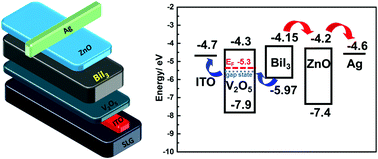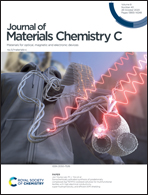All-inorganic and lead-free BiI3 thin film solar cells by iodization of BiSI thin films†
Abstract
Recently, the binary BiI3 semiconductor has emerged as a novel and potential absorbing material for thin film solar cells. In this work, high-quality BiI3 thin films are obtained by a two-step method via iodization of BiSI precursor thin films at low temperatures. The BiSI precursor solution is made via a Bi(OH)3/I2/butylamine/CS2 method. After the iodization process, the BiSI thin film transforms into a large-grain BiI3 absorber layer. The grain size of the BiI3 thin film is more than 1 μm, which leads to a low density of defects. It is worth-noticing that all of the procedures are conducted in open air. The temperature and duration of the iodization process are systematically investigated. By selecting V2O5 and ZnO as a hole extraction layer and an electron transport layer, an all-inorganic BiI3 thin film solar cell with a structure of ITO/V2O5/BiI3/ZnO/Ag is fabricated, yielding a power conversion efficiency of 1.33%, along with an open-circuit voltage of 601 mV, a short-circuit current density of 5.57 mA cm−2 and a fill factor of 39.87%. The un-encapsulated device shows excellent stability, and the performance decreases by only 8.1% after 100 days of storage in dry air.



 Please wait while we load your content...
Please wait while we load your content...